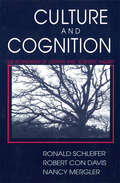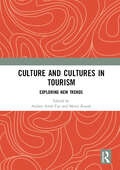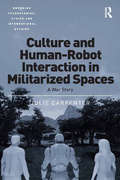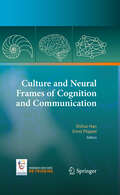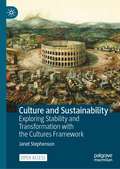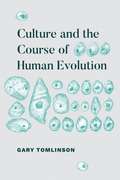- Table View
- List View
Cultural Tourism in the Asia Pacific: Heritage, City and Rural Hospitality
by Tai-Chee Wong Hoon-Peow See Meg MilliganThis book covers multiple cultural tourism aspects including among others, nature and rural conservation policy and conflicts, reflected in case studies, and ethnic minority heritage and their folklore traditions and performances, as well as tourism activities in the city areas. It provides a distinguished quality and an innovative focus to the existing literature by highlighting the unique features and development experience in cultural tourism in the Asia Pacific in both the rural and urban setting. The book has a strong appeal to an international audience, including both tertiary institution academics and students, seeking a better understanding of public policy and cultural tourism practices in the contemporary world.
Cultural Transmission and Evolution: A Quantitative Approach. (MPB-16) (Monographs in Population Biology #93)
by Luigi Luca Cavalli-Sforza Marcus W. FeldmanA number of scholars have found that concepts such as mutation, selection, and random drift, which emerged from the theory of biological evolution, may also explain evolutionary phenomena in other disciplines as well. Drawing on these concepts, Professors Cavalli-Sforza and Feldman classify and systematize the various modes of transmitting "culture" and explore their consequences for cultural evolution. In the process, they develop a mathematical theory of the non-genetic transmission of cultural traits that provides a framework for future investigations in quantitative social and anthropological science.The authors use quantitative models that incorporate the various modes of transmission (for example, parent-child, peer-peer, and teacher-student), and evaluate data from sociology, archaeology, and epidemiology in terms of the models. They show that the various modes of transmission in conjunction with cultural and natural selection produce various rates of cultural evolution and various degrees of diversity within and between groups. The same framework can be used for explaining phenomena as apparently unrelated as linguistics, epidemics, social values and customs, and diffusion of innovations. The authors conclude that cultural transmission is an essential factor in the study of cultural change.
The Cultural Value of Trees: Folk Value and Biocultural Conservation (The Earthscan Forest Library)
by Jeffrey WallThis volume focuses on the tree, as a cultural and biological form, and examines the concept of folk value and its implications for biocultural conservation. Folk value refers to the value of the more-than-human living world to cultural cohesion and survival, as opposed to individual well-being. This field of value, comprising cosmological, aesthetic, eco-erotic, sentimental, mnemonic value and much more, serves as powerful motivation for the local performance of environmental care. The motivation to maintain and conserve ecology for the purpose of cultural survival will be the central focus of this book, as the conditions of the Anthropocene urgently require the identification, understanding and support of enduring, self-perpetuating biocultural associations. The geographical scope is broad with chapters discussing different tree species from the Americas and the Caribbean, East Asia, Eurasia and Australia and Africa. By focusing on the tree, one of the most reliably cross-culturally-valued and cross-culturally-recognized biological forms, and one which invariably defines expansive landscapes, this work illuminates how folk value binds the survival of more-than-human life forms with the survival of specific peoples in the era of biocultural loss, the Anthropocene. As such, this collection of cross-cultural cases of tree folk value represents a low hanging fruit for the larger project of exploring the power of cultural value of the more-than-human living world. This book will be of great interest to students and scholars of conservation, biodiversity, biocultural studies and environmental anthropology.
The Cultural Value of Trees: Folk Value and Biocultural Conservation (The Earthscan Forest Library)
by Jeffrey WallThis volume focuses on the tree, as a cultural and biological form, and examines the concept of folk value and its implications for biocultural conservation. Folk value refers to the value of the more-than-human living world to cultural cohesion and survival, as opposed to individual well-being. This field of value, comprising cosmological, aesthetic, eco-erotic, sentimental, mnemonic value and much more, serves as powerful motivation for the local performance of environmental care. The motivation to maintain and conserve ecology for the purpose of cultural survival will be the central focus of this book, as the conditions of the Anthropocene urgently require the identification, understanding and support of enduring, self-perpetuating biocultural associations. The geographical scope is broad with chapters discussing different tree species from the Americas and the Caribbean, East Asia, Eurasia and Australia and Africa. By focusing on the tree, one of the most reliably cross-culturally-valued and cross-culturally-recognized biological forms, and one which invariably defines expansive landscapes, this work illuminates how folk value binds the survival of more-than-human life forms with the survival of specific peoples in the era of biocultural loss, the Anthropocene. As such, this collection of cross-cultural cases of tree folk value represents a low hanging fruit for the larger project of exploring the power of cultural value of the more-than-human living world. This book will be of great interest to students and scholars of conservation, biodiversity, biocultural studies and environmental anthropology.
Cultural Values and Human Ecology in Southeast Asia (Michigan Papers On South And Southeast Asia #27)
by Karl L. Hutterer A. Terry Rambo George LovelaceEcologists have long based their conceptual frameworks in the natural sciences. Recently, however, they have acknowledged that ecosystems cannot be understood without taking into account human interventions that may have taken place for thousands of years. And for their part, social scientists have recognized that human behavior must be understood in the environment in which it is acted out. Researchers have thus begun to develop the area of “human ecology.” Yet human ecology needs suitable conceptual frameworks to tie the human and natural together. In response, Cultural Values and Human Ecology uses the framework of cultural values to collect a set of highly diverse contributions to the field of human ecology. Values represent an important and essential aspect of the intellectual organization of a society, integrated into and ordained by the over-arching cosmological system, and constituting the meaningful basis for action, in terms of concreteness and abstraction of content as well as mutability and permanence. Because of this balance, values lend themselves to the kinds of analyses of ecological relationships conducted here, those that demand a reasonable amount of specificity as well as historical stability. The contributions to Cultural Values and Human Ecology are exceedingly diverse. They include abstract theoretical discussions and specific case studies, ranging across the landscape of Southeast Asia from the islands to southern China. They deal with hunting-gathering populations as well as peasants operating within contemporary nation-states, and they are the work of natural scientists, social scientists, and humanists of Western and Asian origin. Diversity in the backgrounds of the authors contributes most to the varied approaches to the theme of this volume, because differences in cultural background and academic tradition will lead to different research interests and to differences in the empirical approaches chosen to pursue given problems.
Culturally Adapting Psychotherapy for Asian Heritage Populations: An Evidence-Based Approach
by Wei-Chin HwangCurrent census reports indicate that over half of the United States will be of ethnic minority background by 2050. Yet few published studies have examined or demonstrated the efficacy of currently established psychological treatments for ethnic minorities. Culturally Adapting Psychotherapy for Asian Heritage Populations: An Evidence-Based Approach identifies the need for culturally adapted psychotherapy and helps support the cultural competency movement by helping providers develop specific skillsets, rather than merely focusing on cultural self-awareness and knowledge of other groups. The book provides a top-down and bottom-up community-participatory framework for developing culturally adapted interventions that can be readily applied to many other groups. Areas targeted for adaptation are broken down into domains, principles, and the justifying rationales. This is one of the first books that provides concrete, practical, and specific advice for researchers and practitioners alike. It is also the first book that provides an actual culturally adapted treatment manual so that the reader can see cultural adaptations in action. - Summarizes psychotherapy research indicating underrepresentation of ethnic minorities - Describes the first evidence-based culturally adapted treatment for Asian heritage populations - Provides concrete examples of adapted psychotherapy in practice - Clarifies how this framework can be further used to adapt interventions for other ethnic groups - Highlights how principles used to develop this depression-specific treatment can be applied to other disorders - Includes the full treatment manual Improving Your Mood: A Culturally Responsive and Holistic Approach to Treating Depression in Chinese Americans
Culturally Responsive Science Pedagogy in Asia: Status and Challenges for Malaysia, Indonesia and Japan (Routledge Series on Schools and Schooling in Asia)
by Lilia Halim Murni Ramli Mohd Norawi AliScience learning, for many, is often seen as learning a culture of science knowledge and practices - that is incongruent from one’s everyday experiences and cultural background of learners. This edited volume presents a systemic view of the current initiatives and challenges for the inclusion of Culturally Responsive Science Pedagogy (CRSP) in non-western and multicultural contexts in three Asian countries – Malaysia, Indonesia and Japan. Split into three parts, the book examines the history and current educational systems, curriculums, and socio-cultural diversities in each country, offering an updated review of equity in education. It reflects and expands on the role of CSRP in diverse societies, before going into case studies that feature the experiences of teachers in implementing CRSP in Malaysia, Indonesia and Japan. These snapshots reflect the multiple ways equity is addressed in the teaching and learning of science in Asian countries, allowing readers to extrapolate the possible challenges and best practices for designing and implementing CRSP in practice. The final section examines how these findings provide a sustainable platform for building capacity in understanding of the cultural complexities and realities of recruiting and retaining diverse students into science. One of few books to investigate the role of CRSP in diverse societies in Malaysia, Indonesia and Japan, this book makes a unique contribution to the field of science education with reference to culturally responsive pedagogy. Its strategies and solutions serve as an important comprehensive reference for researchers and science teacher educators.
Culturally Responsive Science Pedagogy in Asia: Status and Challenges for Malaysia, Indonesia and Japan (Routledge Series on Schools and Schooling in Asia)
by Lilia Halim Murni Ramli Mohd Norawi AliScience learning, for many, is often seen as learning a culture of science knowledge and practices - that is incongruent from one’s everyday experiences and cultural background of learners. This edited volume presents a systemic view of the current initiatives and challenges for the inclusion of Culturally Responsive Science Pedagogy (CRSP) in non-western and multicultural contexts in three Asian countries – Malaysia, Indonesia and Japan. Split into three parts, the book examines the history and current educational systems, curriculums, and socio-cultural diversities in each country, offering an updated review of equity in education. It reflects and expands on the role of CSRP in diverse societies, before going into case studies that feature the experiences of teachers in implementing CRSP in Malaysia, Indonesia and Japan. These snapshots reflect the multiple ways equity is addressed in the teaching and learning of science in Asian countries, allowing readers to extrapolate the possible challenges and best practices for designing and implementing CRSP in practice. The final section examines how these findings provide a sustainable platform for building capacity in understanding of the cultural complexities and realities of recruiting and retaining diverse students into science. One of few books to investigate the role of CRSP in diverse societies in Malaysia, Indonesia and Japan, this book makes a unique contribution to the field of science education with reference to culturally responsive pedagogy. Its strategies and solutions serve as an important comprehensive reference for researchers and science teacher educators.
Culture and Climate Resilience: Perspectives from Europe (Palgrave Studies in Climate Resilient Societies)
by Grit MartinezThis book addresses the importance of cultural values, local knowledge and identity in building community resilience in place based contexts. There is a growing impetus among policy makers and practitioners to support and empower capacities of communities under changing climatic conditions. Despite this there is little systematic understanding of why approaches work at local levels or not and what makes some communities resilient and others less so. Europe is typically thought to be well equipped for coping with the effects of a changing climate - because of its moderate climate, its manifold urban-industrialized regions, it’s typically highly skilled population, its successes in science and technology and its advanced climate change policies. However, there is a growing need to understand the effects culture has on communal resiliency and for decision makers and planners to pay attention to historical and cultural characteristics and the complexity of contextualized local conditions to enable successful and durable implementation of climate change policies, programs and measures. This book will be a valuable resource for researchers, students, practitioners and policy makers interested in facilitating sustainable, resilient communities.
Culture and Cognition: The Boundaries of Literary and Scientific Inquiry
by Ronald Schleifer Robert Con Davis Nancy MerglerThis groundbreaking book challenges the disciplinary boundaries that have traditionally separated scientific inquiry from literary inquiry. It explores scientific knowledge in three subject areas—the natural history of aging, literary narrative, and psychoanalysis. In the authors' view, the different perspectives on cognition afforded by Anglo-American cognitive science, Greimassian semiotics, and Lacanian psychoanalysis help us to redefine our very notion of culture.Part I historically situates the concepts of meaning and truth in twentieth-century semiotic theory and cognitive science. Part II contrasts the modes of Freudian case history to the general instance of Einstein's relativity theory and then sets forth a rhetoric of narrative based on the discourse of the aged. Part III examines in the context of literary studies an interdisciplinary concept of cultural cognition.Culture and Cognition will be essential reading for literary theorists, historians and philosophers of science; semioticians; and scholars and students of cultural studies, the sociology of literature, and science and literature.
Culture and Cultural Entities: Toward a New Unity of Science (Synthese Library #170)
by Joseph Margolisviii choice and these include efforts to provide logical frameworks within which wecan make senseof these notions. This series will attempt to bring together work from allof these approaches to the history and philosophy of science and technology in the belief that each has something to add to our understanding. The volumes of this series have emerged either from lectures given by an author while serving as an honorary visiting professor at The City Collegeof New York or from a conference sponsored by that institution. The City College Program in the History and Philosophy of Science and Technology oversees and directs these lectures and conferences with the financial aid of the Association for Philosophy ofScience, Psychotherapy, and Ethics. MARTIN TAMNY RAPHAEL STERN TABLE OF CONTENTS EDITO RS' PR EFACE vii PR EFACE xi ACKNOWLEDGEMENTS xiii I. NATUR E, CULTUR E, AND PERSONS 2. THE CONCEPT OF CONSCIOUSNESS 20 3. ANIMAL AND HUMAN MINDS 42 4 . ACTION AND CAUSALITY 64 5. PUZZLES ABOUT TH E CAUSAL EXPLANATION OF HUMAN ACTIONS 83 6. COGNITIVISM AND THE PROBLEM OF EXPLAINING HUMAN INTELLIGENCE 101 7. WITTGENSTEIN AND NATURAL LANGUAGES : AN ALTERNATIV E TO RATIONALIST AND EMPIRICIST THEO RIE S 133 INDEX 163 PREFACE I have tried to make a fresh beginning on the theory of cultural phenomena, largely from the perspectives of Anglo-American analytic philosophy.
Culture and Cultures in Tourism: Exploring New Trends
by Andres Artal-Tur; Metin KozakAccording to the World Tourism Organization (UNWTO), international tourists engaging in cultural activities accounted for more than 500 million of international tourist numbers in 2017. City tourism relies on culture as a major product, providing benefits not only for interested visitors, but also for the local resident population. New trends in tourism include "experiential tourism", where the interactions between tourists and residents become a key part of the tourism experience and overall customer satisfaction. New technologies and IT applications allow tourists to design their own trip, given the presence of global companies like Trip Advisor, Booking.com and AirBnB. This comprehensive volume explores new trends in cultural tourism, demonstrating how and why culture has become a central factor in tourism. The authors analyse a wide range of relevant issues, including: how heritage-based and cultural tourism could contribute to the sustainability of destinations; the increase of religious travels to and within Arab countries; and how cultural tourism fosters understanding among people and cultures, and could even potentially help to consolidate peace at a regional level. The book also analyses interactions between hosts (the local residents) and guests (the cultural visitors), revisiting the pioneer hippy travelling experiences in Turkey of the 1960s and how they shaped youth culture. This book will be of great interest to students and researchers of cultural tourism. The chapters were originally published in the journal Anatolia.
Culture and Cultures in Tourism: Exploring New Trends
by Andrés Artal-Tur Metin KozakAccording to the World Tourism Organization (UNWTO), international tourists engaging in cultural activities accounted for more than 500 million of international tourist numbers in 2017. City tourism relies on culture as a major product, providing benefits not only for interested visitors, but also for the local resident population. New trends in tourism include "experiential tourism", where the interactions between tourists and residents become a key part of the tourism experience and overall customer satisfaction. New technologies and IT applications allow tourists to design their own trip, given the presence of global companies like Trip Advisor, Booking.com and AirBnB. This comprehensive volume explores new trends in cultural tourism, demonstrating how and why culture has become a central factor in tourism. The authors analyse a wide range of relevant issues, including: how heritage-based and cultural tourism could contribute to the sustainability of destinations; the increase of religious travels to and within Arab countries; and how cultural tourism fosters understanding among people and cultures, and could even potentially help to consolidate peace at a regional level. The book also analyses interactions between hosts (the local residents) and guests (the cultural visitors), revisiting the pioneer hippy travelling experiences in Turkey of the 1960s and how they shaped youth culture. This book will be of great interest to students and researchers of cultural tourism. The chapters were originally published in the journal Anatolia.
Culture and Human-Robot Interaction in Militarized Spaces: A War Story (Emerging Technologies, Ethics and International Affairs)
by Julie CarpenterExplosive Ordnance Disposal (EOD) personnel are some of the most highly trained people in the military, with a job description that spans defusing unexploded ordnance to protecting VIP’s and state dignitaries. EOD are also one of the first military groups to work with robots every day. These robots have become an increasingly important tool in EOD work, enabling people to work at safer distances in many dangerous situations. Based on exploratory research investigating interactions between EOD personnel and the robots they use, this study richly describes the nuances of these reciprocal influences, especially those related to operator emotion associated with the robots. In particular, this book examines the activities, processes and contexts that influence or constrain everyday EOD human-robot interactions, what human factors are shaping the (robotic) technology and how people and culture are being changed by using it. The findings from this research have implications for future personnel training, and the refinement of robot design considerations for many fields that rely on critical small group communication and decision-making skills.
Culture and Human-Robot Interaction in Militarized Spaces: A War Story (Emerging Technologies, Ethics and International Affairs)
by Julie CarpenterExplosive Ordnance Disposal (EOD) personnel are some of the most highly trained people in the military, with a job description that spans defusing unexploded ordnance to protecting VIP’s and state dignitaries. EOD are also one of the first military groups to work with robots every day. These robots have become an increasingly important tool in EOD work, enabling people to work at safer distances in many dangerous situations. Based on exploratory research investigating interactions between EOD personnel and the robots they use, this study richly describes the nuances of these reciprocal influences, especially those related to operator emotion associated with the robots. In particular, this book examines the activities, processes and contexts that influence or constrain everyday EOD human-robot interactions, what human factors are shaping the (robotic) technology and how people and culture are being changed by using it. The findings from this research have implications for future personnel training, and the refinement of robot design considerations for many fields that rely on critical small group communication and decision-making skills.
Culture and Neural Frames of Cognition and Communication (On Thinking)
by Shihui Han and Ernst PöppelShihui Han and Ernst PöppelCultural neuroscience combines brain imaging techniques such as functional magnetic resonance imaging and event-related brain potentials with methods of social and cultural psychology to investigate whether and how cultures influence the neural mechanisms of perception, attention, emotion, social cognition, and other human cognitive processes. The findings of cultural neuroscience studies improve our understanding of the relation between human brain function and sociocultural contexts and help to reframe the “big question” of nature versus nurture. This book is organized so that two chapters provide general views of the relation between biological evolution, cultural evolution and recent cultural neuroscience studies, while other chapters focus on several aspects of human cognition that have been shown to be strongly influenced by sociocultural factors such as self-concept representation, language processes, emotion, time perception, and decision-making. The main goal of this work is to address how thinking actually takes place and how the underlying neural mechanisms are affected by culture and identity.
Culture and Sustainability: Exploring Stability and Transformation with the Cultures Framework
by Janet StephensonThis Open access book brings a cultural lens, and a distinctive analytical framework, to the problem of transitioning to a sustainable, low-carbon future. The world faces a seemingly impossible hurdle – to radically alter long-established social, economic and technological systems in order to live within the biophysical limits of the globe, while ensuring a just and enduring transition. The overarching premise of this book is that this cannot be achieved without widespread cultural change. ‘We need a change in culture’ is often used rhetorically, but what does this really mean?Stephenson starts by exploring culture’s elusiveness, describing its divergent interpretations before identifying core features of culture that are common across most definitions. These characteristics form the core of the cultures framework, an extensively tested approach to studying the links between culture and sustainability outcomes. The framework makes culture an accessible concept which can be analytically applied to almost any sustainability problem. Using many examples from around the world, Stephenson illustrates how cultural stability, cultural flexibility and cultural transformation all have a part to play in the sustainability transition. She guides the reader in the use of the cultures framework for policy development and to underpin research undertaken by individuals or by multi-disciplinary teams.Clearly and engagingly written, Culture and Sustainability is essential reading for academics, students, policy makers and indeed anyone interested in a sustainable future.
Culture and the Course of Human Evolution
by Gary TomlinsonThe rapid evolutionary development of modern Homo sapiens over the past 200,000 years is a topic of fevered interest in numerous disciplines. How did humans, while undergoing few physical changes from their first arrival, so quickly develop the capacities to transform their world? Gary Tomlinson’s Culture and the Course of Human Evolution is aimed at both scientists and humanists, and it makes the case that neither side alone can answer the most important questions about our origins. Tomlinson offers a new model for understanding this period in our emergence, one based on analysis of advancing human cultures in an evolution that was simultaneously cultural and biological—a biocultural evolution. He places front and center the emergence of culture and the human capacities to create it, in a fashion that expands the conceptual framework of recent evolutionary theory. His wide-ranging vision encompasses arguments on the development of music, modern technology, and metaphysics. At the heart of these developments, he shows, are transformations in our species’ particular knack for signmaking. With its innovative synthesis of humanistic and scientific ideas, this book will be an essential text.
Culture and the Course of Human Evolution
by Gary TomlinsonThe rapid evolutionary development of modern Homo sapiens over the past 200,000 years is a topic of fevered interest in numerous disciplines. How did humans, while undergoing few physical changes from their first arrival, so quickly develop the capacities to transform their world? Gary Tomlinson’s Culture and the Course of Human Evolution is aimed at both scientists and humanists, and it makes the case that neither side alone can answer the most important questions about our origins. Tomlinson offers a new model for understanding this period in our emergence, one based on analysis of advancing human cultures in an evolution that was simultaneously cultural and biological—a biocultural evolution. He places front and center the emergence of culture and the human capacities to create it, in a fashion that expands the conceptual framework of recent evolutionary theory. His wide-ranging vision encompasses arguments on the development of music, modern technology, and metaphysics. At the heart of these developments, he shows, are transformations in our species’ particular knack for signmaking. With its innovative synthesis of humanistic and scientific ideas, this book will be an essential text.
Culture and the Course of Human Evolution
by Gary TomlinsonThe rapid evolutionary development of modern Homo sapiens over the past 200,000 years is a topic of fevered interest in numerous disciplines. How did humans, while undergoing few physical changes from their first arrival, so quickly develop the capacities to transform their world? Gary Tomlinson’s Culture and the Course of Human Evolution is aimed at both scientists and humanists, and it makes the case that neither side alone can answer the most important questions about our origins. Tomlinson offers a new model for understanding this period in our emergence, one based on analysis of advancing human cultures in an evolution that was simultaneously cultural and biological—a biocultural evolution. He places front and center the emergence of culture and the human capacities to create it, in a fashion that expands the conceptual framework of recent evolutionary theory. His wide-ranging vision encompasses arguments on the development of music, modern technology, and metaphysics. At the heart of these developments, he shows, are transformations in our species’ particular knack for signmaking. With its innovative synthesis of humanistic and scientific ideas, this book will be an essential text.
Culture and the Course of Human Evolution
by Gary TomlinsonThe rapid evolutionary development of modern Homo sapiens over the past 200,000 years is a topic of fevered interest in numerous disciplines. How did humans, while undergoing few physical changes from their first arrival, so quickly develop the capacities to transform their world? Gary Tomlinson’s Culture and the Course of Human Evolution is aimed at both scientists and humanists, and it makes the case that neither side alone can answer the most important questions about our origins. Tomlinson offers a new model for understanding this period in our emergence, one based on analysis of advancing human cultures in an evolution that was simultaneously cultural and biological—a biocultural evolution. He places front and center the emergence of culture and the human capacities to create it, in a fashion that expands the conceptual framework of recent evolutionary theory. His wide-ranging vision encompasses arguments on the development of music, modern technology, and metaphysics. At the heart of these developments, he shows, are transformations in our species’ particular knack for signmaking. With its innovative synthesis of humanistic and scientific ideas, this book will be an essential text.
Culture and the Course of Human Evolution
by Gary TomlinsonThe rapid evolutionary development of modern Homo sapiens over the past 200,000 years is a topic of fevered interest in numerous disciplines. How did humans, while undergoing few physical changes from their first arrival, so quickly develop the capacities to transform their world? Gary Tomlinson’s Culture and the Course of Human Evolution is aimed at both scientists and humanists, and it makes the case that neither side alone can answer the most important questions about our origins. Tomlinson offers a new model for understanding this period in our emergence, one based on analysis of advancing human cultures in an evolution that was simultaneously cultural and biological—a biocultural evolution. He places front and center the emergence of culture and the human capacities to create it, in a fashion that expands the conceptual framework of recent evolutionary theory. His wide-ranging vision encompasses arguments on the development of music, modern technology, and metaphysics. At the heart of these developments, he shows, are transformations in our species’ particular knack for signmaking. With its innovative synthesis of humanistic and scientific ideas, this book will be an essential text.
Culture and the Course of Human Evolution
by Gary TomlinsonThe rapid evolutionary development of modern Homo sapiens over the past 200,000 years is a topic of fevered interest in numerous disciplines. How did humans, while undergoing few physical changes from their first arrival, so quickly develop the capacities to transform their world? Gary Tomlinson’s Culture and the Course of Human Evolution is aimed at both scientists and humanists, and it makes the case that neither side alone can answer the most important questions about our origins. Tomlinson offers a new model for understanding this period in our emergence, one based on analysis of advancing human cultures in an evolution that was simultaneously cultural and biological—a biocultural evolution. He places front and center the emergence of culture and the human capacities to create it, in a fashion that expands the conceptual framework of recent evolutionary theory. His wide-ranging vision encompasses arguments on the development of music, modern technology, and metaphysics. At the heart of these developments, he shows, are transformations in our species’ particular knack for signmaking. With its innovative synthesis of humanistic and scientific ideas, this book will be an essential text.
Culture and Utilization of Live Food Organisms for Aquahatcheries
by Jham Lal Sahil H. S. MogalekarIn today's world, food scarcity and food security are significant global concerns, with 811 million people suffering from hunger and 3 billion individuals unable to afford healthy diets. This book discusses fisheries and aquaculture as crucial contributors to nutritional security and the need for sustainable practices to meet the growing demand. The subject matter of this book covers: Recycling of Waste Through Tubifex Culture and Used as Live Food in Aquahatcheries Culture Techniques of Daphnia Mosquito Larval Control Through the Larvivorous Fish Chlorella Live Food: Cultivation and Applications Print edition not for sale in South Asia (India, Sri Lanka, Nepal, Bangladesh, Pakistan and Bhutan)
Culture and Utilization of Live Food Organisms for Aquahatcheries
by Jham Lal Sahil H. S. MogalekarIn today's world, food scarcity and food security are significant global concerns, with 811 million people suffering from hunger and 3 billion individuals unable to afford healthy diets. This book discusses fisheries and aquaculture as crucial contributors to nutritional security and the need for sustainable practices to meet the growing demand. The subject matter of this book covers: Recycling of Waste Through Tubifex Culture and Used as Live Food in Aquahatcheries Culture Techniques of Daphnia Mosquito Larval Control Through the Larvivorous Fish Chlorella Live Food: Cultivation and Applications Print edition not for sale in South Asia (India, Sri Lanka, Nepal, Bangladesh, Pakistan and Bhutan)







